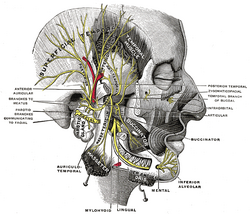Assessment |
Biopsychology |
Comparative |
Cognitive |
Developmental |
Language |
Individual differences |
Personality |
Philosophy |
Social |
Methods |
Statistics |
Clinical |
Educational |
Industrial |
Professional items |
World psychology |
Biological: Behavioural genetics · Evolutionary psychology · Neuroanatomy · Neurochemistry · Neuroendocrinology · Neuroscience · Psychoneuroimmunology · Physiological Psychology · Psychopharmacology (Index, Outline)
| Muscles of mastication | ||
|---|---|---|
| Mandibular division of the trifacial nerve. | ||
| Latin | musculi masticatorii | |
| Gray's | subject #109 385 | |
| Origin: | ||
| Insertion: | ||
| Blood: | ||
| Nerve: | mandibular nerve | |
| Action: | ||
| Dorlands/Elsevier | m_22/12549778 | |
Mastication is accomplished through the activity of the four muscles of mastication.
Muscles[]
- The masseter
- The temporalis (the sphenomandibularis is considered a part of the temporalis by some sources, and a distinct muscle by others)
- The medial pterygoid
- The lateral pterygoid
Each of these primary muscles of mastication is paired, with each side of the mandible possessing one of the four.
Innervation and embryological origin[]
Unlike most of the other facial muscles, which are innervated by the facial nerve, or CN VII, the muscles of mastication are all innervated by the trigeminal nerve, or CN V. More specifically, they are innervated by the mandibular branch, or V3. This is a testament to their shared embryological origin from the first branchial arch.
The muscles of facial expression, on the other hand, derive from the second branchial arch.
Origin and insertion[]
In humans, the mandible, or lower jaw, is connected to the temporal bone of the skull via the temporomandibular joint, an extremely complex joint which permits movement in all planes. The muscles of mastication originate on the skull and insert into the mandible, thereby allowing for jaw movements during contraction.
Function[]
The mandible is the only bone that moves during mastication and other activities, such as talking.
While these four muscles are the primary participants in mastication, other muscles are usually if not always helping the process, such as those of the tongue and the cheeks.
External links[]
scalp/eyelid: occipitofrontalis (occipitalis, frontalis) - orbicularis oculi - corrugator supercilii - depressor supercilii
extraocular: levator palpebrae superioris - superior tarsal - rectus (superior, inferior, medial, lateral) - oblique (superior, inferior) - intraocular: ciliary - iris dilator - iris sphincter
ear: auriculares - temporoparietalis - stapedius - tensor tympani
nose: procerus - nasalis (dilatator naris) - depressor septi nasi - levator labii superioris alaeque nasi
mouth: levator anguli oris/depressor anguli oris - levator labii superioris/depressor labii inferioris - zygomaticus (major, minor) - mentalis - buccinator - orbicularis oris - risorius
mastication: masseter - temporalis - pterygoid (lateral, medial)
tongue: extrinsic (genioglossus - hyoglossus - chondroglossus - styloglossus) intrinsic (superior longitudinal - inferior longitudinal - transversus - verticalis)
soft palate: levator veli palatini - tensor veli palatini - musculus uvulae - palatoglossus - palatopharyngeus
pharynx: pharyngeal constrictor (inferior, middle, superior) - stylopharyngeus - salpingopharyngeus
larynx: cricothyroid - posterior cricoarytenoid - lateral cricoarytenoid - arytenoid - thyroarytenoid
| This page uses Creative Commons Licensed content from Wikipedia (view authors). |
